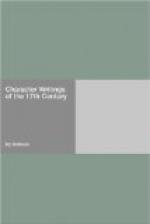Earle was a man so gentle and liberal, that while Clarendon described him as “among the few excellent men who never had and never could have an enemy,” Baxter wrote in the margin of a kindly letter from him, “O, that they were all such!” and Calamy described him as “a man that could do good against evil, forgive much out of a charitable heart.” The Parliament, even just before depriving him as a malignant, had put him to the trouble of declining its nomination as one of the Westminster Assembly of Divines. As a Bishop in the early days of Charles the Second he did all he could to oppose the persecuting spirit of the first Conventicle Act and of the Five Mile Act.
Dr. Philip Bliss, who died in 1857, after a life marked by many services to English Literature, chose Bishop Earle’s “Characters” for one of his earlier studies, published in 1811, when his own age was twenty-four. His book[2] included an account of Bishop Earle himself, a list of his writings, publication for the first time of some of his early verses, his correspondence with Baxter, and a Chronological List of Books of Characters from 1567 to 1700, which was the first contribution to a study of this feature in our Seventeenth Century Literature. Bliss took his text of Earle from the edition of 1732, collated with the first impression in 1628. As the Characters which now follow are given with Bliss’s text and notes, I add what the editor himself says of his method. The variations of the 1732 text from the first impressions in 1628 are thus distinguished: “Those words or passages which have been added since the first edition are contained between brackets_ [and printed in the common type]; those which have received some alteration are printed in italic; and the passages, as they stand in the first edition, are always given in a note."
MICROCOSMOGRAPHY;
OR,
A PIECE OF THE WORLD CHARACTERIZED.
A CHILD
Is a man in a small letter, yet the best copy of Adam before he tasted of Eve or the apple; and he is happy whose small practice in the world can only write this character. He is nature’s fresh picture newly drawn in oil, which time, and much handling, dims and defaces. His soul is yet a white paper[3] unscribbled with observations of the world, wherewith, at length, it becomes a blurred note-book. He is purely happy, because he knows no evil, nor hath made means by sin to be acquainted with misery. He arrives not at the mischief of being wise, nor endures evils to come, by foreseeing them. He kisses and loves all, and, when the smart of the rod is past, smiles on his beater. Nature and his parents alike dandle him, and tice him on with a bait of sugar to a draught of wormwood. He plays yet, like a young prentice the first day, and is not come to his task of melancholy. [4][All the language he speaks yet is tears, and they serve him well enough to express




